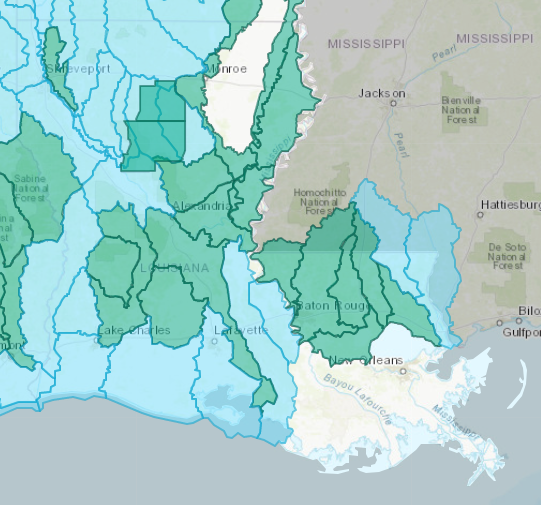Mapping
- FEMA National Flood Hazard Layer (NFHL) viewer The National Flood Hazard Layer is a geospatial database that contains current effective flood hazard data.
- FEMA Map Service Center The FEMA Flood Map Service Center is the official public source for flood hazard information produced in support of the National Flood Insurance Program.
- LSU Ag Center Floodmaps The LSU AgCenter FloodMaps system is unique in that it integrates flood risk information with ground elevation data (provided by a service of the US Geological Survey).
- Map Changes Viewer The Flood Map Changes Viewer includes the following: preliminary National Flood Hazard Layer, preliminary Changes Since Last FIRM, the Preliminary Map Comparison Tool, and the pending National Flood Hazard Layer, and the National Flood Hazard Later.
- Mapping Information Platform The MIP provides the latest tools and technology for digital flood map production to support the goals of FEMA and other mapping stakeholders.
- Region VI Mitigation Awareness Portal The FEMA Region 6 Mitigation Awareness Portal shows the footprints of active Risk MAP Projects for all the five states (New Mexico, Oklahoma, Texas, Arkansas, and Louisiana) in Region 6.
- LOMA/LOMR Application
- eLOMA Fact Sheet
Base Level Engineering (BLE) Approach
Base Level Engineering (BLE) is an efficient modeling and mapping approach that aims to provide technically credible flood hazard data at various geographic scales such as community, parish, watershed, and/or state level. This data is meant to compliment the current effective Flood Insurance Rate Map (FIRM) data, but not replace it. For areas where no flood hazard data exists, the BLE dataset may be the only source of flood risk data.
With a mix of currently available and future datasets from both BLE and other studies, it is expected that for some parts of the state multiple sources of flood data will be available. To decide which source takes priority, factors including, but not limited to, study level (detailed or approximate) and age of the study should be considered. BLE is considered an approximate study and users should always default to the detailed studies on the FIRM if they are available. This BLE data can be used as best available information for areas with no flood mapping information and areas identified on regulatory FIRM as Zone A. For detailed flood zones, such as Zone AE areas on the FIRM, BLE can only be used if the data is more conservative (see example below).
Base Level Engineering (BLE) Application
An example of BLE data taking precedence over detailed mapping would be when flood elevation is 10ft for a property according to the regulatory FIRM map, whereas the elevation as per BLE data is 11ft. Since the flood elevation for the property would have more conservative elevation requirements according to the BLE data, it is acceptable to use this information rather than the less restrictive elevation designated on the regulatory FIRM.
Please refer to FEMA's resources for additional information and tutorials for how to best use BLE data. Additionally, FEMA's Decision Matrix is available to help users understand when it is appropriate to use the BLE data and when it is not.
Base Level Engineering (BLE) Tools and Resources
Tools, templates and resources in the list below assist communities for the local review and incorporation of Base Level Engineering datasets in their floodplain management activities. These tools connect up with BLE data available, free-of-charge, on the interactive on-line portal, known as the Estimated Base Flood Elevation (estBFE) Viewer.
Resources below are intended for use by state, tribal and local elected officials, technical community departments/staff, engineering and development industry, community and natural hazard planning staff across the nation.
Base Level Engineering (BLE) Status Map
This interactive map application provides the current progress of BLE development throughout the state. Chose the Download Datasets and Models option when clicking on the Estimated Base Flood Elevation (estBFE) Viewer to see the status of available data. For watersheds with status 'complete' (meaning BLE development is complete for that watershed) access and download the BLE modeling files and results by going to FEMA's Estimated Base Flood Elevation Viewer.
Order Maps - 1-(877) FEMA MAP (1-877-336-2627)

BLE study area with data available for download
BLE study area with data preparation in progress